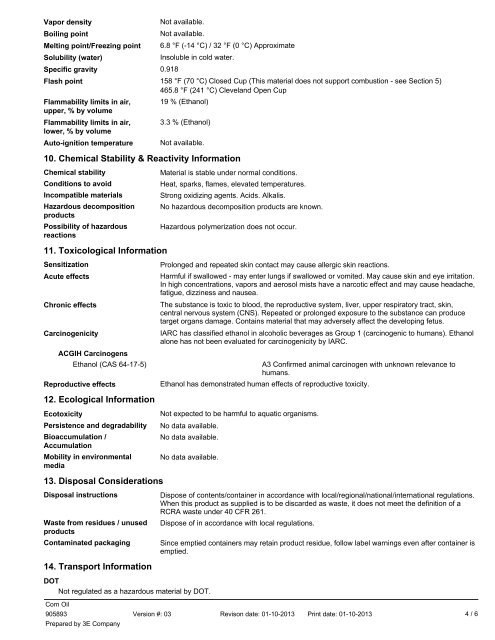Corn Oil - Valero
Corn Oil - Valero Corn Oil - Valero
Vapor densityBoiling pointMelting point/Freezing pointSolubility (water)Specific gravity 0.918Not available.Not available.6.8 °F (-14 °C) / 32 °F (0 °C) ApproximateInsoluble in cold water.Flash point 158 °F (70 °C) Closed Cup (This material does not support combustion - see Section 5)465.8 °F (241 °C) Cleveland Open CupFlammability limits in air,upper, % by volumeFlammability limits in air,lower, % by volumeAuto-ignition temperature19 % (Ethanol)3.3 % (Ethanol)Not available.10. Chemical Stability & Reactivity InformationChemical stabilityConditions to avoidIncompatible materialsHazardous decompositionproductsPossibility of hazardousreactionsMaterial is stable under normal conditions.Heat, sparks, flames, elevated temperatures.Strong oxidizing agents. Acids. Alkalis.No hazardous decomposition products are known.Hazardous polymerization does not occur.11. Toxicological InformationSensitizationAcute effectsChronic effectsCarcinogenicityACGIH CarcinogensEthanol (CAS 64-17-5)Reproductive effectsProlonged and repeated skin contact may cause allergic skin reactions.Harmful if swallowed - may enter lungs if swallowed or vomited. May cause skin and eye irritation.In high concentrations, vapors and aerosol mists have a narcotic effect and may cause headache,fatigue, dizziness and nausea.The substance is toxic to blood, the reproductive system, liver, upper respiratory tract, skin,central nervous system (CNS). Repeated or prolonged exposure to the substance can producetarget organs damage. Contains material that may adversely affect the developing fetus.IARC has classified ethanol in alcoholic beverages as Group 1 (carcinogenic to humans). Ethanolalone has not been evaluated for carcinogenicity by IARC.A3 Confirmed animal carcinogen with unknown relevance tohumans.Ethanol has demonstrated human effects of reproductive toxicity.12. Ecological InformationEcotoxicityPersistence and degradabilityBioaccumulation /AccumulationMobility in environmentalmediaNot expected to be harmful to aquatic organisms.No data available.No data available.No data available.13. Disposal ConsiderationsDisposal instructionsWaste from residues / unusedproductsContaminated packagingDispose of contents/container in accordance with local/regional/national/internat ional regulations.When this product as supplied is to be discarded as waste, it does not meet the definition of aRCRA waste under 40 CFR 261.Dispose of in accordance with local regulations.Since emptied containers may retain product residue, follow label warnings even after container isemptied.14. Transport InformationDOTNot regulated as a hazardous material by DOT.Corn Oil905893Prepared by 3E CompanyVersion #: 03Revison date: 01-10-2013 Print date: 01-10-2013CPH MSDS NA4 / 6
IATANot regulated as dangerous goods.IMDGNot regulated as dangerous goods.TDGNot regulated as dangerous goods.General15. Regulatory InformationTest results from Sustained Combustion testing (ASTM D-4206) indicate that this material doesnot sustain combustion.US federal regulations This product is hazardous according to OSHA 29 CFR 1910.1200.All components are on the U.S. EPA TSCA Inventory List.TSCA Section 12(b) Export Notification (40 CFR 707, Subpt. D)Not regulated.Clean Air Act (CAA) Section 112 Hazardous Air Pollutants (HAPs) ListNot regulated.CERCLA (Superfund) reportable quantity (lbs) (40 CFR 302.4)NoneSuperfund Amendments and Reauthorization Act of 1986 (SARA)Hazard categoriesSection 302 extremelyhazardous substance (40CFR 355, Appendix A)Section 311/312 (40 CFR370)Drug EnforcementAdministration (DEA) (21 CFR1308.11-15)WHMIS statusWHMIS classificationWHMIS labelingImmediate Hazard - YesDelayed Hazard - YesFire Hazard - YesPressure Hazard - NoReactivity Hazard - NoNoYesNot controlledControlledB3 - Combustible LiquidsD2A - Other Toxic Effects-VERY TOXICD2B - Other Toxic Effects-TOXICInventory statusCountry(s) or region Inventory name On inventory (yes/no)*AustraliaAustralian Inventory of Chemical Substances (AICS)YesCanadaCanadaChinaEuropeEuropeJapanKoreaNew ZealandDomestic Substances List (DSL)Non-Domestic Substances List (NDSL)Inventory of Existing Chemical Substances in China (IECSC)European Inventory of Existing Commercial ChemicalSubstances (EINECS)European List of Notified Chemical Substances (ELINCS)Inventory of Existing and New Chemical Substances (ENCS)Existing Chemicals List (ECL)New Zealand InventoryYesNoYesYesNoNoYesYesCorn Oil905893Prepared by 3E CompanyVersion #: 03Revison date: 01-10-2013 Print date: 01-10-2013CPH MSDS NA5 / 6
- Page 1 and 2: MATERIAL SAFETY DATA SHEET1. Produc
- Page 3: Canada. Alberta OELs (Occupational
Vapor densityBoiling pointMelting point/Freezing pointSolubility (water)Specific gravity 0.918Not available.Not available.6.8 °F (-14 °C) / 32 °F (0 °C) ApproximateInsoluble in cold water.Flash point 158 °F (70 °C) Closed Cup (This material does not support combustion - see Section 5)465.8 °F (241 °C) Cleveland Open CupFlammability limits in air,upper, % by volumeFlammability limits in air,lower, % by volumeAuto-ignition temperature19 % (Ethanol)3.3 % (Ethanol)Not available.10. Chemical Stability & Reactivity InformationChemical stabilityConditions to avoidIncompatible materialsHazardous decompositionproductsPossibility of hazardousreactionsMaterial is stable under normal conditions.Heat, sparks, flames, elevated temperatures.Strong oxidizing agents. Acids. Alkalis.No hazardous decomposition products are known.Hazardous polymerization does not occur.11. Toxicological InformationSensitizationAcute effectsChronic effectsCarcinogenicityACGIH CarcinogensEthanol (CAS 64-17-5)Reproductive effectsProlonged and repeated skin contact may cause allergic skin reactions.Harmful if swallowed - may enter lungs if swallowed or vomited. May cause skin and eye irritation.In high concentrations, vapors and aerosol mists have a narcotic effect and may cause headache,fatigue, dizziness and nausea.The substance is toxic to blood, the reproductive system, liver, upper respiratory tract, skin,central nervous system (CNS). Repeated or prolonged exposure to the substance can producetarget organs damage. Contains material that may adversely affect the developing fetus.IARC has classified ethanol in alcoholic beverages as Group 1 (carcinogenic to humans). Ethanolalone has not been evaluated for carcinogenicity by IARC.A3 Confirmed animal carcinogen with unknown relevance tohumans.Ethanol has demonstrated human effects of reproductive toxicity.12. Ecological InformationEcotoxicityPersistence and degradabilityBioaccumulation /AccumulationMobility in environmentalmediaNot expected to be harmful to aquatic organisms.No data available.No data available.No data available.13. Disposal ConsiderationsDisposal instructionsWaste from residues / unusedproductsContaminated packagingDispose of contents/container in accordance with local/regional/national/internat ional regulations.When this product as supplied is to be discarded as waste, it does not meet the definition of aRCRA waste under 40 CFR 261.Dispose of in accordance with local regulations.Since emptied containers may retain product residue, follow label warnings even after container isemptied.14. Transport InformationDOTNot regulated as a hazardous material by DOT.<strong>Corn</strong> <strong>Oil</strong>905893Prepared by 3E CompanyVersion #: 03Revison date: 01-10-2013 Print date: 01-10-2013CPH MSDS NA4 / 6



